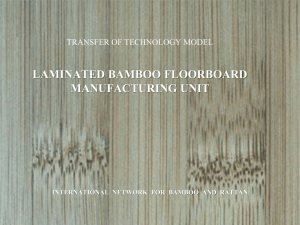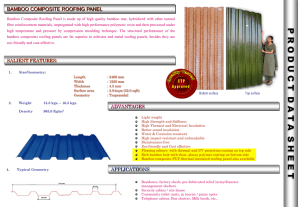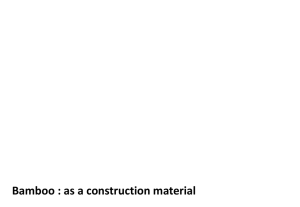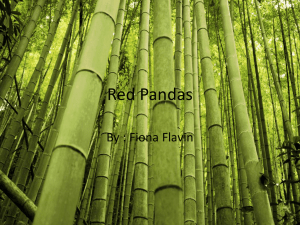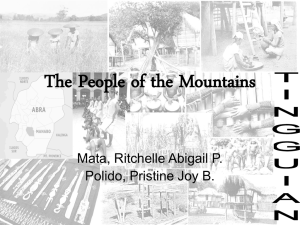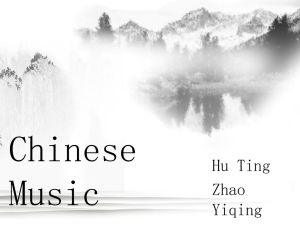Pollination - African Green Developments (Pty) Ltd.
advertisement
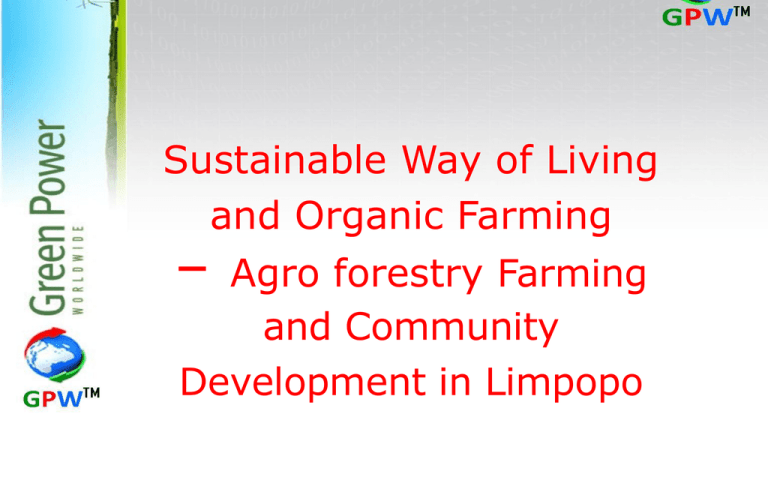
Sustainable Way of Living and Organic Farming – Agro forestry Farming and Community Development in Limpopo In this beautiful planet. Every single minute 34 people Every single day 50,000 people are dying in extreme poverty and hunger. 1/3 of world population (Approximately 2 billion) is still suffering from poverty and hunger Challenges for Traditional Farming ■ ■ ■ ■ ■ ■ Low fertility land Distance to markets High transport cost Short shelf life of traditional crops High input cost Limited off-take / uses for traditional crops Agro Forestry ■ Must not be confused with commercial timber forests that take 15 to 25 years to provide income. ■ Is not a mono culture, environmentally degrading practice. ■ Is a environmentally friendly use of companion plants and natural feed supply to derive the maximum possible income from a limited portion of land with lowest possible input cost ■ Agro forestry restore natural Flora and Fauna in area. Return, with natural habitat, wild animals (and poachers'? Need to deploy Police service and anti poaching unit) Selected plant species ■ ■ ■ ■ ■ Bamboo Pinatta Moringa (Short Term) Jicama (Short Term) Algae Bamboo Bamboo ■ A naturalized clumping bamboo. ■ Non invasive as it does not produce seed ■ Root system penetrates only 500mm – 600mm ■ Culms 100mm to 120mm in diameter ■ Height from 9 to 27 meters (up to 45meters) ■ Produces 25 new shoots / year ■ Culm wet weight average 35kg ■ 100 m/ton, minimum, Bio Mass per Ha ■ ■ ■ ■ The fastest growing plant on this planet . Is a critical element in the balance of oxygen and carbon dioxide in the atmosphere. A viable replacement for wood An enduring natural resource Versatile with a 105 day growth cycle A renewable resource for agro forestry production. And over 2.2 billion people rely on bamboo as a source of income. Bamboo ■A sustainable bamboo investment combines managed forestry with the potential for short-term profitability, delivering returns just four years after planting – making it a stable and dependable source of annual income. And its potential is set to increase... dramatically. Sustainable timber, in all its forms, represents the most secure asset type available, with an increase in the demand for tropical hardwood increasing over 2,500 percent in the last 40 years. According to statistics released by the Ministry of Agriculture in India, the world market for bamboo is currently valued at $10 billion (USD). That value is forecast to reach $20 billion (USD) by 2015. The reason: high demand. Fast Growth. Bamboo is the fastest growing land plant in the world (only ocean kelp grows faster). A 20m bamboo culm can replace itself within 50 days as opposed to a 20m hardwood tree which can take decades to grow. Longevity. A single bamboo clump can produce up to 15 kilometres of usable pole over a 15 year period. Carbon Sequestration. Bamboo sequesters around 4 times more CO2 than average timber and produces 35% more Oxygen. Strength. Bamboo possesses a tensile strength of 52 pounds per square inch, stronger than most steel. As such it is a major component in the construction industry for scaffolding across Asia, South America and Africa. “During the past 20 years, bamboo has developed as an exceptionally-valuable and often superior substitute for wood. Bamboo may replace wood in many industrial applications and thereby contribute to the saving and restoration of the world’s forests”. United Nations Bamboo Some facts to consider about the greenness of bamboo would be: Bamboo is grown without pesticides or chemical fertilizers Bamboo requires no irrigation Bamboo rarely needs replanting Bamboo grows rapidly and can be harvested in 3-5 years Bamboo produces 35% more oxygen that an equivalent stand of trees Bamboo is a critical element in the balance of oxygen and carbon dioxide in the atmosphere Bamboo is an excellent soil erosion inhibitor Additionally, bamboo fabric is breathable, thermal regulating, wicks moisture better than polyester performance fabrics, will resist odour and is absorbent and fast drying keeping you dryer and more comfortable than any cotton or polyester fabrics. Is bamboo organically grown? Yes, our viscose from bamboo comes from bamboo that is Certified Organic and you can see our certifications and read about them on our website:https://www.bamboosa.com/bamboo.php?PID=65. The farm where the bamboo is grown is certified by the OCIA and the bamboo crops are certified by the USDA organic seal. Bamboo Uses Lets take a look at the Bamboo Revolution: From Activated Charcoal, Biochar for water/air purification to Producing a high grade coal, replacement to Bio Diesel. From Paper to Bamboo fibre (clothing etc). Floors, Walls panels and Kitchen tops, Structural Beams & Roofing. Renewable energy options: Captive Gasification Co and Tri-generation, Bituminous Coal replacement. Pellet fuel for home cooking and heating Renewable consumer products: Timber replacement; Steel rods replacement(in concrete); http://www.indiamart.com/anilbamboomachines/bamboo-flooringmachine.html Edible oil; Food fortification products Animal feeds; Organic Nitrogen Fertilizer; Soil amendment All from single project design. Carbon sequestering / Offset opportunities There are now over 5000 products made from Bamboo Bamboo’s economic and environmental potential About 1.5 billion people depend on bamboo for their daily lives. Over 20 million tons of bamboo are collected and utilized annually. Those in rural areas and the poor are the prime harvesters of bamboo, widely known as a "poor man’s timber". Global bamboo trade is estimated to be between 1.5 to 2.5 billion USD. Although it occupies only 1-3% of the total tropical and sub-tropical forest area, including trees outside forest lands, bamboo contributes between 4-7% of the total tropical and subtropical timber trade. Besides higher biomass, bamboo has other advantages over wood as a carbon stock. Unlike woody crops bamboo offers the possibility of annual selective harvesting and removal of about 15-20% of the total stock without damaging the environment and stock productivity. Over 90% of bamboo carbon can be sequestered in durable products such as boards, panels, floors, furniture, buildings, cloth, paper and activated charcoal. These products have a very long life span and may retain carbon for several decades. Bamboo can play a significant role in linking climate change mitigation to sustainable economic development in the developing world. Carbon credits may trigger creation of otherwise marginal bamboo plantations for processing, jobs and wealth generation. Using Bamboo in forestry projects under the Clean Development Mechanism. The Kyoto Protocol and the CDM forestry projects Interest in carbon trading under the Clean Development Mechanism (CDM) of the Kyoto Protocol have blossomed since its ratification in 2004. The first carbon trade forestry projects under the Kyoto Protocol are expected in 2008. Although no projects have been developed for bamboo so far, it does qualify for the forest carbon credits. Agricultural uses Moringa Moringa This tree is cultivated around the world for its edible leafs and pods. ■ The tree is extremely drought tolerant ■ The tree is fast growing and reaches 6 meters in two years. ■ The tree starts production 8 months after establishment. ■ The tree is cut back to 1 meter above ground every winter and starts coppicing within 2 weeks. ■ Companies selling Moringa oil UncleHarry.com Eromatic.co.uk Fromnaturewithlove.com Gracefruit.com Moringafarms.com Qty 1oz 100ml 2oz 100ml 4oz Price $12 $12 $15.23 $8.55 $25 Yield Approximate Yield/hectare @250 trees/hectare (estimates)* Good Conditions for growth: Poor Optimal Seed in Shell (Yield) 16.30 27.17 50 t/ha Seed (46% of Yield) 7.5 12.5 23t/ha oil (40% oiseed) 3 5 9.66 t/ha Meal: 4.5 7.5 13.34 t/ha Protein 2.25 3.75 6.67 t/ha Starch 2.25 3.75 6.67 t/ha MORINGA OIL FOR BIOFUEL? No! For food, Feed Stock! Medicine and cosmetics. In the Philippines, SECURA International announced that Moringa trees will be grown on 500,000 hectares to supply oil for sale to North American Biofuels, Inc. SECURA plans to export 150 million gallons of Moringa oil annually. In Australia, Moringa Pty Ltd is establishing Moringa plantations on 500,000 hectares. We do not use eatable products for Biofuel. People need food! Animals need feed stock! Fast tracking new entrants in agriculture ■ It is not possible to establish large numbers of traditional commercial farmers on the land with the limited funding available ■ It will take years for new entrants to compete with established commercial farmers, if they follow traditional farming practice of monoculture ■ We have to think outside the box without compromising food security ■ Develop Communal approaches, how to deal with feedstock for animals, feed lots for finishing, abattoir, food processing plants, storage facility, marketing of products (do not sale raw materials, only final products) and transportation to clients Moringa Oil and Seed pods Moringa Leafs, powder and drinks Pinnata Pinnata Pinnata Pinnata Seed / Pod Content Each seed pod contains 6% oil - 94% seedcake The encased seed accounts for 45-95% of the weight of each seed pod (depending on variety and management) The seed itself consists of 40-50% lipid oil, and 40-60% seedcake Seed cake The rich seed cake remaining after pressing the seed can be utilised as organic fertiliser, high protein animal stock feed, or biomass for heat and power generation. Plantation Prunings Mulched prunings from Pinnata can be utilised as organic fertiliser, high protein animal stock feed, or biomass for heat and power generation. Pinnata Millettia Pinnata is a superior species of Pinnata. It is a “green oil” Bio-fuel producing tree that has a 10 meter taproot, thus creating a substantial carbon sink. The dense shade it provides slows the evaporation of surface water and its root structures promote nitrogen fixation, which moves nutrients from the air into the soil. Pinnatta easily surpasses the plantation oil yield of other oil crops such as Palm and Jatropha, with high oil content of 40-50%. In addition, the rich seed cake remaining after pressing the seed can be utilized as organic fertilizer, high protein animal stock feed, or biomass for heat and power generation. Pinnata plantations can fix more carbon than is used in the production of fuel - creating a truly "carbon negative" solution. Pinnata trees at maturity regularly produce 800 - 1,000kgs of seed per tree per year. Pinnata One Seed, Many Products Vegetable oils can be used to supplement or even replace traditional petroleum fuels. The glycerol in the remaining 10 percent has a wide range of applications, including use in cosmetics and pharmaceuticals. In fact, almost every step in the life cycle of pongamia seeds results in a safe and useful product: highly effective organic fertilizer. Widespread use of gas for cooking could also help curb the rampant deforestation. The toxic compounds that make pongamia seeds repellent to grazing livestock can be extracted to create a potent natural pesticide. There is also research indicating that M. pinnata can be used as a natural insecticide.[15] Research has also been put into using the material leftover from the oil extraction as a feed supplement for cattle, sheep and poultry as this byproduct contains up to 30% protein. Other studies have shown some potential for biocidal activity against V. cholerae and E. coli, as well an anti-inflammatory, antinociceptive (reduction in sensitivity to painful stimuli) and antipyretic (reduction in fever) properties. While the oil and residue of the plant are used in many traditional remedies.[7] Juices from the plant, as well as the oil, are antiseptic and resistant to pests. The fruits and sprouts of P. pinnata were used in folk remedies for abdominal tumours in India, the seeds for keloid tumours in Sri Lanka and a powder derived from the plant for tumours in Vietnam. In Sanskritic India, seeds were used for skin aliments. Today, the oil is used as a liniment for rheumatism. Leaves are active against Micrococcus; their juice is used for cold, cough, diarrhoea, dyspepsia, flatulence, gonorrhoea and leprosy. Roots are used for cleaning gums, teeth and ulcers. Bark is used internally for bleeding piles. In the traditional systems, such as Ayurveda and Unani, the P. pinnata plant is used for anti-inflammatory, anti-plasmodial, anti-nonciceptive, antihyperglycaemics, anti-lipidoxidative, anti-diarrhoeal, anti-ulcer, anti-hyperammonic and antioxidant. Oil made from the seeds, known as pongamia oil, is an important asset of this tree and has been used as lamp oil, in soap making, and as a lubricant for thousands of years. Jicama Plant description ■ Jicama is actually a legume, and it grows on vines that may reach six meters in length. The vines tend to hug the ground, terminating in tubers that may grow to 22 kilograms in size, although the majority of jicama tubers sent to market are approximately 750 g- 1,5 kg in weight. ■ Jicama sequesters approximately 52 tons of nitrogen / ha / season Jicama ■ Jicama is a winter crop, it develops the tubers in the short days. ■ This will allow for 33.000 plants per ha and produce 24,75 tons Jicama tubers / ha ■ Jicama tubers can be eaten raw, cooked, fried like potato chips, mashed, milled into porridge or made into sweet / chilli snacks. ■ The seed contains an oil that is a very potent insect repellent that can be used on organically grow crops and for bio oil crude. Selected plant species Algae Selected plant species Algae Algae can produce up to 300 times more oil per acre than conventional crops, such as rapeseed, palms, soybeans, or jatropha. As algae have a harvesting cycle of 1–10 days, it permits several harvests in a very short time frame, a differing strategy to yearly crops). Algae can also be grown on land that is not suitable for other established crops, for instance, arid land, land with excessively saline soil, and droughtstricken land. This minimizes the issue of taking away pieces of land from the cultivation of food crops. Algae can grow 20 to 30 times faster than food crops. Energy production Business possibility of using algae to make gasoline, diesel and other fuels. See Algae fuel. Other uses Chlorella, particularly a transgenic strain which carries an extra mercury reductase gene, has been studied as an agent for environmental remediation due to its ability to reduce Hg2+ to the less toxic elemental mercury. Cultivated algae serve many other purposes, including bioplastic production, dyes and colorant production, non chemical feedstock production, and pharmaceutical ingredients. ■ Algae: 60 tons x 100ha(year one, say 60 t/ha) = 6 000 ton of oil ; • and 60 000 ton feed cakes. Algae-derived Nutritional Supplements & Oils High-Omega3; Low-Omega3 ■ Bamboo: 100 tons x 10 000 ha (from year 3) = 1 000 000 ton of Biomass ■ Pinnata:18 tons x 5 000 ha (from year 3) = 90 000 ton of Oil and 150 000 ton of feed stock ■ Moringa oil: 2.5 tons x 10 000 ha (from year 3) = 25 000 ton of Oil and 50 000 ton Bio products ■ Jicama: 25 tons x 1 000 ha (from year 2) = 25 000 ton of food Pollination All our plantations, except Bamboo and Algae, need pollination! Pollination Pollination is the process by which pollen (male) in transferred from the ripe anther to the receptive stigma in a flower of the same species, thereby enabling fertilisation of the ovary (female) and the production of fruit and seeds (the reproduction of the plant). Only 10% of flowering plants are pollinated without animal assistance (i.e. selfpollinated, wind pollinated, or water pollinated). Our plantation of Moringa, Pinnata and Jicama need pollination to increase quantity of harvesting product and quality of products. Globally, honeybees are the most important pollinator of commercial pollinatordependant crops, with at least 90% of these crops reliant on honeybee services. The following key points should be included in the plan: • Approximate date to move bees into the crop, or the time relative to a certain condition of bloom, and the approximate date on which bees are to be removed • Location of crop • Pattern of colony placement • Beekeeper will provide a specified number of colonies of a minimum standard • Grower will reimburse the beekeeper for any additional movement of colonies in, out, or around the crop • Grower will provide right of entry to the beekeeper for management of the bees while on the pollination site Pollination Estimated yields on ONE Ha Plot ■ ■ ■ ■ ■ ■ Algae Bamboo Pinnata Moringa seeds Moringa pods Jicama 100 to 140 m.ton/ha 100 to 160 ton/ha 40 tons 5 tons 24 tons 27,5 tons Estimated Oil yields on ONE Ha Plot/year ■ Algae 60 tons ■ Bamboo 50 tons ■ Pinnata 18 tons ■ Moringa oil 2.5 tons ■ Jicama 2.5 tons Carbon Credits ■ As the bamboo and tree species are recognized by the UN as forest species, the establishment of these plantations is eligible for carbon credits. ■ If well organized and established on land that has been denuded of trees or has never had trees, each ha may be worth as much as $2000 / year/ha in carbon funding. Carbon Credits –Environment •Offsets 2,650 000 tons/yr of CO2 & 40,000 tons/yr of Methane –Provides over 4 billion calories/year from food & 3.5 billion calories/year from animal feed for assisting foodaid organizations –Powered by 100% renewable energy •On-site Solar PV & Waste-to-Energy power generation •Nearly 9 MW of power by gas turbines generators on methane( 3 units x 3 MW) •Offset, from power generation, equivalent of 1,600k tons/yr of CO2 •Collecting/avoiding use of 3 million cubic meters of freshwater/yr Bio-Diesel Production Mobile processing plant 160miI liter / year fixed plant Benefits in Limpopo and for Limpopo Immediate Access to approximately 75,000Ha Land Waste Water Treatment Bio Digesters for Gray water for feed Algae , Organic Compost for long term Plantations and Gas Methane for feed Algae and distribution for Community use Planned 500 units houses for workers, 50 units for management and 10 units for top management Develop Guest House and Game Lodge with Game farm, crocodile farm and bee farm Develop Company Centre: Office, Cultural Centre, Planet Fitness Health Club, Agricultural College, School, Shopping Centre, Restaurant and Cafe, Health Care Clinic with Linkedcare. Access to extra, under utilised, 25 000 Ha to 50 000Ha, Non Arable land Close to road and easy access to port for products export. Easy establish production of building materials by our plant and community handcraft unit, food, pulp for paper and material, fuel production. Easy Access to Site and Access to fresh water Full Community Support Challenges in Area Housing Backlog Limited access to basic services amongst Poor. Problem with Preschool and Training Centres, schools Poor life condition, low level of sanitation, waste, is a major Health and Social Problems in area Hugh unemployment between Youth and Women Hugh clean water shortage Electricity is limited and paraffin, candles and LPG are becoming more and more expensive Environment is degraded with problems of over grassing, Water Weeds and Alien Vegetation, runoff soil Farms have problems with feed stock for animals Farms have problems of disposing of animal wastes Fertility of land is low for conventional farming activity Proposal We have offer 75 000 ha for Self Sustainable Farming in Limpopo. for year one: ESTIMATED PLANTATION DEVELOPMENT TIME LINES AND REQUIREMENTS FOR : SHORT, MEDIUM TERM PRODUCTIVE SUSTAINABILITY 5 000 ha Pinnata 10 000 ha Bamboo 10 000 ha Moringa oleifera 5 000 ha Jicama for year two: 5 000 ha Pinnata 10 000 ha Bamboo 10 000 ha Moringa oleifera 5 000 ha Jicama LONG TERM PRODUCTIVE SUSTAINABILITY 1000 ha – dependant on personal and market requirements options would be; 600 ha Algae (open ponds) for stage one and 6 000ha for stage 2 Install Pyrolysis equipment and 10 000m3 Biogas Digester’s Systems fed from Farming activity , Company Village and waste from production of Oil plants Recycle water and extract Biogas Utilise Gas to drive Turbine Genset (approximately 10MW) and supply Bio Gas in cylinders to Community. Utilise Water and fertiliser for Sustainable way of Farming Develop Marketing and Job Creation Centre Develop all available land in phases starting with energy, oil and food production then moving towards Biofuels from long and short term plantation, what is must be plant as soon as we start Project. Requirements Operational Capital from our investors Purchase of Equipment and machinery. Pyrolysis equipment Order and install Temporary office, Warehouses and workshops Start cleaning up land for plantation Purchase of crop seedlings for start and open Nursery, for own seedlings stock growing PV energy generation, Co generation and Three generation systems, Gas and steam Turbine Generators Construction of office, warehouses, work shops, Dormitory and houses. Green Houses and Pig Farm with Chicken Farm. Abattoir and Biogas Digesters Ponds for Algae growing Production plant for Oil extraction and feed cakes processing Feed stock production from our own plantation Food processing, packaging System Super Structure Solid Biomass Future Energy Crop of Africana Spirotakia, Bamboo, Windy Bundu etc Pyrolysis Gasification Bio Oil Fuel Gas Combustion HEAT ELECTRICITY Wet Biomass Poultry litter, Pig litter, cow dung, household kitchen waste, agroprocessing waste, sewerage, waterweeds, sewerage from existing waste works Anaerobic Fermentation BioGas Economic Sustainability Each Plantation, Oil Plants, food and feed stock processing, Create Direct and Indirect Sustainable Jobs Bamboo Plantation with processing plant and building materials plant Create Direct and Indirect Sustainable Jobs Project could have “Commercial IRR of 13% over 10 years Provision of Energy has been shown to have positive impact on economic activity, Poverty Alleviation and Self sustainability of Community Development of Food Production industry to stimulate Economic Activities Possible sale of Electricity and Compost Development of Future Energy Crops Improved Land Use Decentralised management and use of Resource Flows, Education of Youth, Woman, mind change for further developments in Limpopo and South Africa Social Sustainability . No indoor smoke from cooking or heating thereby promoting a healthy way of life Food gardens produce trade and supply of Food Improvement of appearance of village due to greening projects by using nutrient rich grey water Flushing toilets improving morale in the community Compliments conventional systems Creation of direct and indirect employment opportunities thru education Potential to seed self reliance in relatively new economies Creation of Community Cooperation with AGD partnership, for develop self sustainable system, what is can alleviate Community to new level What is can utilise new, advance, agricultural technology for communal benefits. 365 days Organic feed stock for all Communal Coop live stock (in AGD Feed Lots), Abattoir, Packaging, Freezer and Transport No risk, Maximum profit, Job creation and excess to market. Environmental Sustainability • • • • • • • No burning of paraffin, coal and wood thereby reducing emissions Sludge from the biogas digester makes for good bio-fertiliser which will be used for green projects as well as food and future bio-energy crop production Reuse of water from digester after it is filtered Cleaning up of area by control of water weed and alien vegetation bringing a better and healthy environment Local investment and infrastructure upgrade Better waste management and sanitation provision Nutrient reclamation

